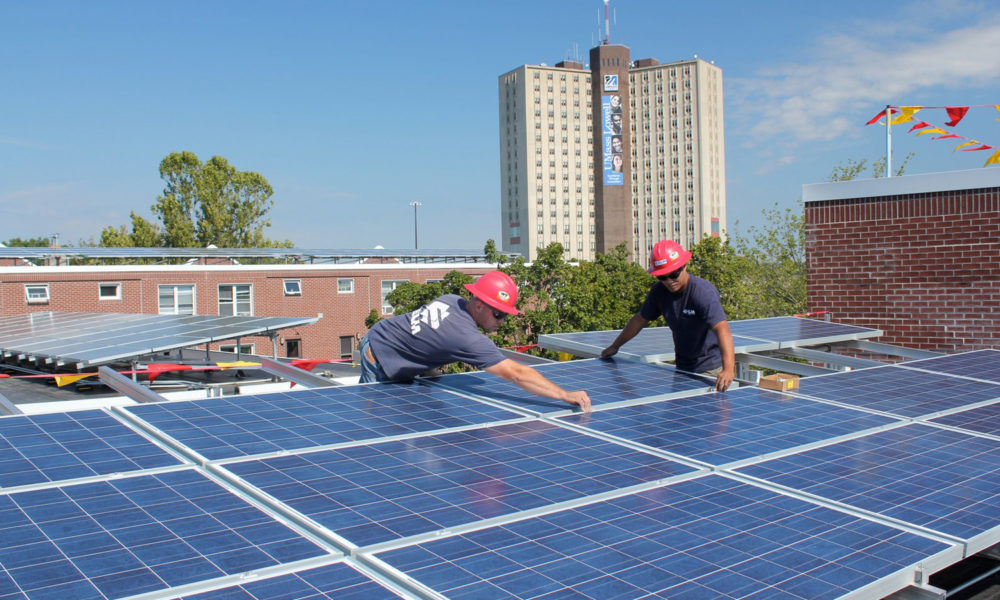When we look at the devastating effects of climate change and the role that fossil fuels play, research shows we need to replace fossil fuels with affordable clean tech based on renewable energy. However, funding and creating that technology are not enough. In the United States, renewable energy technology, like solar cells, is still mostly utilized by white populations when data show that communities of color are impacted most negatively by fossil fuel pollution and climate change.
So how do we ensure that renewable energy technologies alleviate the burdens of climate change for everyone? The answer lies in the realization of environmental justice, an equity campaign rooted in the 1960s civil rights movement and nationally catalyzed by the 1982 Warren County Protests, which centers on the idea that all people, regardless of their identities, should have the right to live in a safe and healthy environment.
The legacy of racist housing policies
To understand how complex the path to environmental justice is, it is important to understand one cause of the racial wealth gap in the United States: property ownership. In 1934, the Federal Housing Administration (FHA) was established to provide loans for people to purchase homes. The FHA refused to give loans to Black people via a policy known as “redlining,” which lasted well into the late 1960s. From 1934 to 1968, 98% of loans approved were given to white people. According to the Center for American Progress, despite the 1968 Fair Housing Act, which ended federal redlining, the effects of discriminatory housing policies and segregation persist in US cities today.

New housing apartment building next to Interstate Highway 5 Golden State Freeway Los Angeles, California
The FHA’s overwhelming bias in loan approval for white families in the 20th century resulted in the suburbs today remaining majority white. Pew reported in 2018 that 21% of US rural, 32% of suburban, and 56% of urban populations are non-white. As a result of racist housing policies, Black and Latino/x people are twice as likely as white people to rent their homes. Without equitable and improved housing policies, people of color, especially Black people, are more likely to live in fence-line communities (communities bordering industry). Consequently, Black people are exposed to 38% more pollution than white people nationwide. In the Northeastern and mid-Atlantic states, non-white people are exposed to 66% more air pollution from vehicles than white people.
Technology without comprehensive policy worsens inequities
Rooftop solar cells have seen remarkable market growth recently, expanding by 50% per year from 2012 to 2019. Due to this growth, communities of color should have guaranteed access to an energy landscape that moves toward clean and renewable energy sources given they experience the most detriment from climate change. However, a study out of Tufts University and the University of California, Berkeley shows that for deployment of rooftop solar cells, adoption and access are far from ubiquitous.
When considering economic discrepancies like income, white-majority neighborhoods still showed an average of 21% more solar implementation than non-racial-majority communities compared with Black and Latino/x majority neighborhoods which showed 69% and 30% less solar deployment, respectively, on average across all income levels. When homeownership data were considered, white-majority communities still showed 37% more rooftop solar use on average. The authors of the Tufts/UC Berkeley study suggest one reason for this inequity in solar adoption may be the lack of racial diversity and representation within the solar industry. As of 2017, three-quarters of the solar workforce was white, and 78 to 90% of management positions were held by white people.
As an additional consequence of racist housing policies, people of color—especially Black and Latino/x people—are more likely to face energy poverty, meaning their homes lack good energy infrastructure. Therefore, they must devote a disproportionate amount of their income to utility bills. Because of the upfront charges, the clean energy transition could initially increase costs for energy-impoverished households. Implementation of clean energy technologies without considering the legacy of racism in the US and its detrimental economic effects will only perpetuate inequality.
Plenty of policies are already making an impact
Many state and federal policies attempt to chip away at the clean energy imbalance. Federal programs like the US Department of Energy’s SunShot Initiative provide funding opportunities for solar cell research, manufacturing, and installation. Some state policies are working, like California’s many successful single-family and community solar initiatives. States like Colorado and Illinois also implemented successful environmental justice policies by deploying community solar gardens and financial incentives for solar vendors to install rooftop solar in low-income communities.

June 02, 2017 – Red Oak Park won an international award for affordable housing. (Photo by Dennis Schroeder / NREL)
However, last year, California instituted mandates that all new homes must include solar panels, increasing housing costs. Despite significant savings in electricity bills, this upfront financial barrier prices low-income communities out of these options. Blanket policies to increase the adoption of renewable energy technology in isolation without centering environmental justice fail to help marginalized communities that should otherwise benefit most during the transition away from fossil fuels.
It is not enough for engineers like me to design solar cells to mitigate climate change. In our society, privileged people will still benefit most. It takes policymakers, non-profit organizers, community leaders, politicians, and every one of us to ensure this technological revolution is accompanied by equitable housing, weatherization programs, resource education, and community care. With the advent of the Biden-Harris administration, science and environmental justice are now centered in national policy. We must continue to pressure our elected officials to center environmental justice as we fight climate change.

